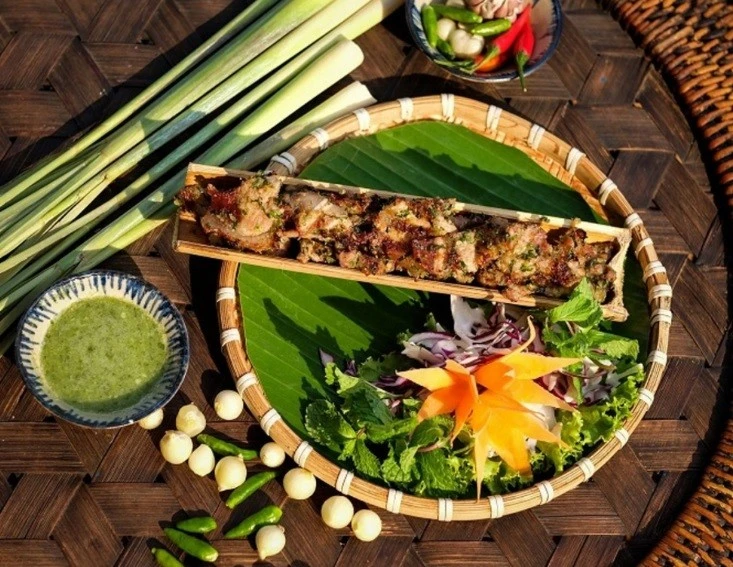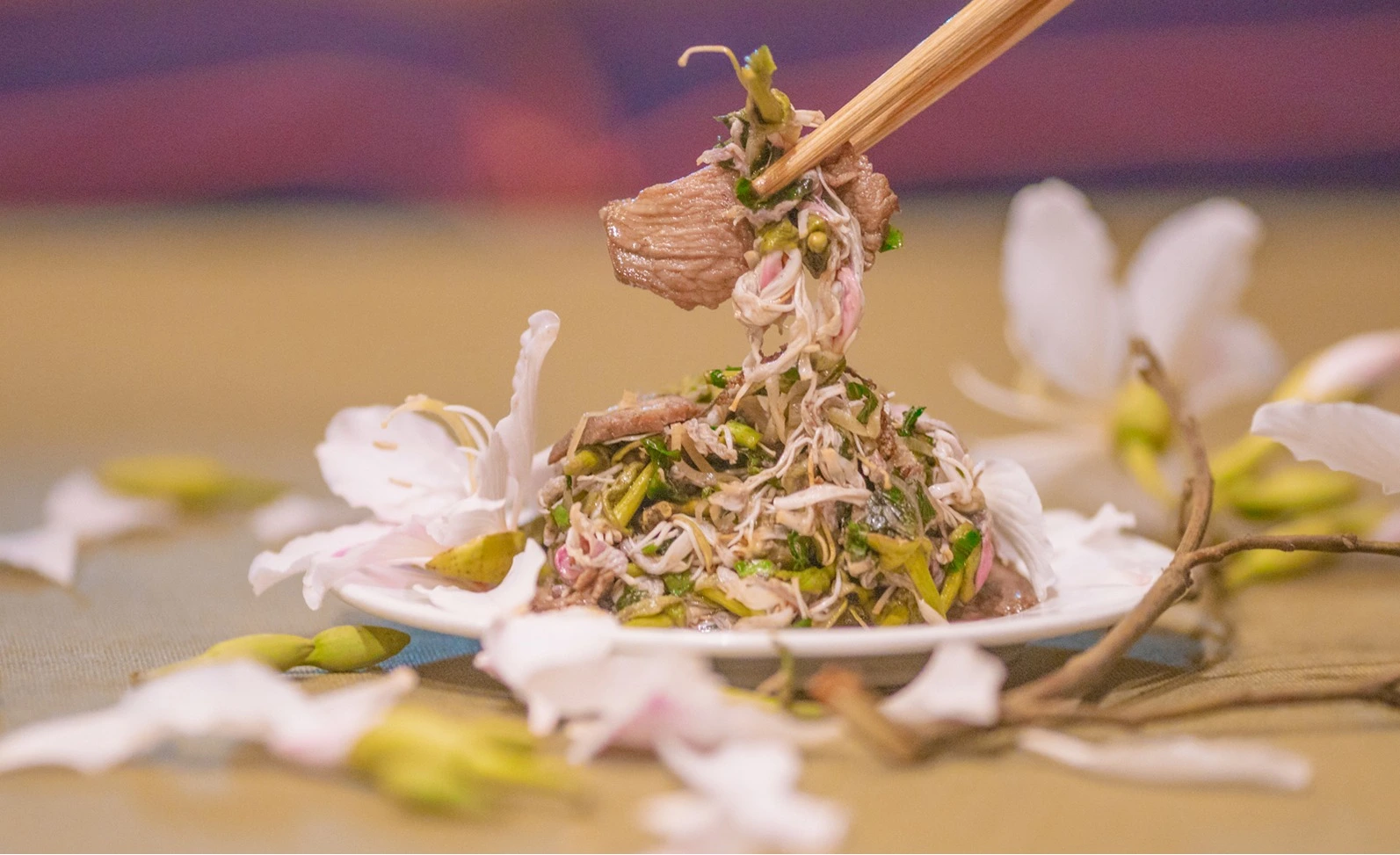Purple sticky rice
Purple sticky rice is a famous specialty of the Thai ethnic group, Day,... in Lai Chau, it is cooked from large, thin and even grain glutinous rice, so when eaten, it has a natural aroma that is quite attractive. In particular, this sticky rice dish also has a beautiful purple color made from the kou plug tree – a typical forest tree only found in Lai Chau.
To make delicious and flavorful purple sticky rice, the locals must carry out a meticulous and feat processing process. They must use the right type of wood made from fig trees so that sticky rice and sticky rice must be stored on the wood stove. Absolutely no sticky rice with electric stoves and gas stoves to ensure that the dish has a delicious taste.
According to locals, this purple sticky rice is not only delicious and beautiful, but also healthy. The leaves of the plant contain many nutrients, which are useful for enhancing intestinal function. Therefore, this dish is loved by local people not only during Tet holidays but also on weekdays.

Photo: @diepdo1406
Bamboo shoots with banana flowers
Referring to Lai Chau specialties, it is impossible not to mention the delicate bamboo shoots with banana flowers, processed from fish and the quintessential vegetables and flowers of the land here.
To make delicious banana flower bamboo shoots, people use bamboo shoots or bitter bamboo shoots. After that, the bamboo shoots are finely chopped and soaked in salt water and then boiled twice in water, let dry. If you use bamboo shoots, you need to strip them into bite-sized pieces after boiling. Bamboo shoots with banana flowers have a blend of many sour, spicy, salty, bitter, sweet, fleshy, stimulating taste buds, so it is often enjoyed by locals and diners at the beginning of spring, helping to clear the heat and refresh.
With banana flowers, locals choose fresh, thick-petaled flowers. The fish is made from stream fish, firm meat, and is preliminarily processed by grilling and filtering the meat and removing bones. After that, the ingredients are mixed with a mixture of sweet and sour garlic paste, add finely chopped basil to wake up the aroma.

Photo: Tran Phuong Thao
Salad with vegetables
Salad is a rustic dish, imbued with the mountainous flavor of the Thai people in Lai Chau in particular and the Northwest people in general. To make delicious lettuce, the locals often choose to pick young tops of vegetables and cake leaves, then wash them and dry them in the sun to have a moderate wilt.
Before processing, the vegetables are cooked instead of boiled, ensuring that the vegetables retain their sweet taste and have a beautiful green color. When the vegetables are cooked, people put the vegetables in a large bowl, season with spices such as salt, sugar, lemon juice and add finely chopped herbs, chili, ginger, garlic and mix well. Wait for about 5 minutes for the mannequin to absorb the spices, add roasted peanuts and pound them to enjoy.
Bean sprouts (also known as "quails" in Thai) look like ferns, with large stems, wide foliage, and smooth green leaf surfaces. This plant grows only on the banks of streams, ravines, where there is high humidity.
In addition to the dummy, spinach is also processed by Thai people into many other unique dishes such as stir-fried spinach with garlic, stir-fried spinach with sour bamboo shoot sauce...

Photo: Pham Thi Thuy Hien
Bitter leaf soup
One of the famous specialties of Lai Chau that visitors should not miss when they have the opportunity to visit here is bitter leaf soup. This dish is prepared from the main ingredients of bitter leaves (also known as duck bile leaves), lungs and pig secretions.
In order to pick delicious bitter leaves, the indigenous people have to creep into the forest edges and streams. Because picking leaves is quite laborious and time-consuming, in the past, this soup was often only processed by the host to entertain distinguished guests.
Bitter leaf soup makes first-time eaters wary of the bitter taste, but when you get used to it, you will feel the unmistakable taste of this specialty.
Bitter leaves after picking are washed and crumpled. Pork lungs are carefully prepared, then chopped and seasoned, seasoned accordingly. Wait for the mixture to soak evenly for about 10 minutes, then put it on the stove, bring it to a boil, then add the bitter leaves and crumbled herbs to cook.

Photo: VnE
Lam
Although it has a strange name, causing curiosity to tourists, in fact, lam nho is a dish made from familiar ingredients such as beef and buffalo meat. In the Thai national language, lam means to grill, nho means to bake, lam nho means "to bake (until cooked)".
To make a standard dish, Thai people must choose pieces of buffalo meat or beef that have just been slaughtered, ensuring the freshest and keeping the sauce intact. Next, the meat is blotted clean of excess secretions/blood with a dry cloth instead of washing through water. This method helps the meat retain its deliciousness and avoid bacteria from entering.
Lam nho dish has a strong sweet taste, soft meat, sticking together, diners have to use chopsticks to roll up each piece before they can enjoy.
The meat after cleaning will be grilled on embers. When the meat is cooked, it is sliced into thin slices, mixed with typical spices of the highlands such as ginger, garlic, chili, and macadamia,... After that, the marinated meat will be put into bamboo tubes with some vegetables, grilled evenly on a charcoal stove.
When the meat fibers start to tighten again, people will take out the meat, use chopsticks to loosen it and then put it back in a bamboo tube, grilling it for the last time for the lam nho dish to be cooked.

Photo: Internet
Source: VNN
